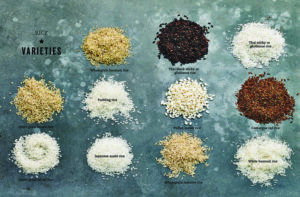Celebrating National Rice Month
By Sharon Schweitzer
The history of National Rice Month which is celebrated in September, started in 1991, when President George H.W. Bush designated the month as such. The president and the United States Rice Federation came to an agreement to celebrate and recognize the usage of the grain in our daily lives. Consider this, dishes around the globe may vary, depending on region and the numerous culinary skills employed in incorporating this staple. In regions such as Asia, Africa, the Caribbean Central, North and South America, and the Middle East, rice is prepared in numerous styles. Whether it’s boiled, creamed, stir-fried, steamed, or mixed, savory, spicy, sticky, or sweet. Interestingly, enough, in the United States, county officials in Mississippi, celebrate the annual festivities with a rice tasting luncheon.
Despite the fact that rice has important social, religious, and cultural significance worldwide, are you aware of the different types that exist?
Korean: Korean hyunmi refers to Korean short grain brown rice. Unlike white rice, brown rice has the bran and germ still attached. Brown rice tends to have a higher nutritional value than white rice, with many vitamins and fiber. It takes longer to cook and longer to digest. Many Koreans combine white rice and brown rice together to bring better texture and taste.
Indian: Indian basmati is also long-grain rice, meaning that the grains are long and skinny. When cooked, basmati rice is less sticky than jasmine, with grains that tend to remain on the firm side. Basmati rice also doesn’t stick together as Jasmine rice does, which makes it a great choice for rice pilaf, salads, and Indian rice side dishes that often include safron, lemon or turmeric.
Japanese or Sushi: Sushi rice is steamed Japanese rice that is flavored with vinegar-based seasonings and it’s only used for making sushi. In Japan, it is known as sumeshi (vinegared rice). Sushi rice is usually short grain rice, which has plump grains and a high proportion of amylopectin, a type of sticky starch that’s responsible for the trademark creamy texture of risotto.
Have a rice day with your favorite bowl!
Photo by Quadrille Publishing
Sharon Schweitzer JD, is a diversity and inclusion consultant, cross-cultural trainer, etiquette expert, and the founder of Access to Culture. In addition to her accreditation in intercultural management from the HOFSTEDE Centre, she is an attorney and mediator. Sharon served as a Chinese Ceremonial Dining Etiquette Specialist in the documentary series Confucius was a Foodie, on Nat Geo People. Her Amazon #1 Best Selling book in International Business, Access to Asia: Your Multicultural Business Guide, won a coveted Kirkus Star, and was named to Kirkus Reviews’ Best Books. She’s a winner of numerous awards, including the British Airways International Trade Award at the Greater Austin Business Awards.
#SharonSchweitzer, #AccesstoCulture, Access2Culture, #InternationalCelebration, #AccesstoAsia, #GlobalEtiquette, #Cross-CulturalTrainer, #InterculturalCommunication, #InternationalCommunication, #Interculturalist, #Etiquette, #CultureExpert, #Speaker, #KeynoteSpeaker, #RiceMonth, #AsianCulture #AsianCuisine, # #CulturalIntelligence, #KoreanCulture, #IndianCulture, #JapaneseCulture


Leave A Comment